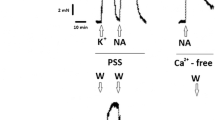Summary
We investigated the possible contribution of surrounding passive cardiac tissue to the smooth muscle responses of coronary arteries. The vasoactive properties of the intramyocardial septal artery (outer diameter 350–400 µm) of the rat heart were investigated when it was freed from the surrounding cardiac tissue (dissected artery) and when it remained in the left ventricle and was thus embedded in passive cardiac tissue (in situ). The changes in external diameter relative to the maximal diameter (isoproterenol) resulting from the application of 125 mM KCl and 1,000 µU/ml vasopressin were measured at 37°C, a transmural pressure of 100cm H2O, and zero flow. In the dissected septal arteries (n = 5) the maximum diameter was 402 ± 16 µm, while during exposure to KCl and vasopressin the diameter was reduced to 66.1 ± 4.6% and 74.2 ± 3.0%, respectively. For the in situ arteries (n = 6), the maximal diameter was 386 ± 28 µm, a value not statistically different from the dissected vessels and the diameters reduced to 63.2 ± 5.5% and 65.6 ± 7.2% due to KCl and vasopressin, respectively. The constrictions of dissected arteries and in situ arteries were statistically not different. The results show that the maximally-dilated diameter and the constriction responses of intramyocardial conduit arteries of the rat heart are not affected by the surrounding passive cardiac tissue.
Similar content being viewed by others
References
Krams R, Sipkema P, Westerhof N (1990) Varying elastance concept may explain coronary systolic flow impediment. Am J Physiol 257:H1471-H1479
Suga H, Sagawa K, Shoukas AA (1973) Load independence of the instantaneous pressure-volume ratio of the canine left ventricle and effects of epinephrine and heart rate on the ratio. Circ Res 32:314–322
Kanatsuka H, Lamping KG, Eastham CL, Marcus ML (1990) Heterogenous changes in epimyocardial microvascular size during graded coronary stenosis. Circ Res 66:389–396
Kanatsuka H, Eastham CL, Marcus ML, Lamping KG (1992) Effects of nitroglycerin on the coronary microcirculation in normal and ischemic myocardium. J Cardiovasc Pharmacol 19:755–763
Resar J, Livingston JL, Halperin HR, Sipkema P, Krams R, Yin FCP (1990) Effect of wall stretch on coronary hemodynamics in isolated canine interventricular septum. Am J Physiol 259:H1869-H1880
Hoogerwerf N, Van der linden PJW, Sipkema P (1989) Effects of oxygen and flow on the diameter of the femoral artery of the rabbit. Blood Vessels 26:360–367
Sipkema P, Van der Linden PJW, Hoogerwerf N, Westerhof N (1989) Does the endothelium play a role in flow-dependent constriction? A study in the isolated rabbit femoral artery. Blood Vessels 26:368–377
Hoogerwerf N, Zijlstra EJ, Van der Linden PJW, Westerhof N, Sipkema P (1992) Endothelium function is protected by albumin and flow-induced constriction is independent of endothelium and tone in isolated femoral artery. J Vasc Res 29:367–375
Kuo L, Davis MJ, Chilian WM (1988) Myogenic activity in isolated subepicardial and subendocardial arterioles. Am J Physiol 255:H1558–1562
Van Beek JHGM, Bouma P, Westerhof N (1990) Coronary resistance increase by non-defatted albumin in saline perfused rabbit heart. Am J Physiol 259:H1606–1608
Goodman LS, Gillman A (1985) The pharmacological basis of therapeutics, 7th edn. Macmillan, New York
Jones CJH, Kuo L, Davis MJ, Chilian WM (1992) Paradoxical in vivo and in vitro responses of coronary arterioles to α-adrenergic activation. Faseb J 6:A2076
Walker BR, Childs ME, Adams EM (1988) Direct cardiac effects of vasopressin: Role of V1- and V2-vasopressinergic receptors. Am J Physiol 255:H261–265
Dominguez-Mon M, Ponce-Homos JE, Gomez R, Cannata M, Taquini AC (1984) Energetic, metabolic, and contractile effects of vasopressin in mammalian heart. Methods Find Exp Clin Metabolism 6:373–378
Kanatsuka H, Lamping KG, Eastham CL, Dellsperger KC, Marcus ML (1989) Comparison of the effects of increased myocardial oxygen consumption and adenosine on the coronary microvascular resistance. Circ Res 65:1296–1305
Author information
Authors and Affiliations
Additional information
Some of these results were presented during the 5th World Congress for Microcirculation, September 1991, Louisville, Kentucky
This research is supported in part by grant HL44399-01A1 from NIH. The North Atlantic Treaty Organization Grant 0089-88, for International Collaborative Research, to P. Sipkema is also gratefully acknowledged.
Rights and permissions
About this article
Cite this article
Sipkema, P., van der Linden, P.J.W. & Westerhof, N. Smooth muscle responses of the rat septal artery are not influenced by surrounding passive cardiac tissue. Heart Vessels 8, 181–185 (1993). https://doi.org/10.1007/BF01744740
Received:
Accepted:
Issue Date:
DOI: https://doi.org/10.1007/BF01744740




